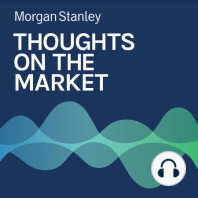4 min listen

U.S. Economy: Is Inventory Outpacing Sales?
U.S. Economy: Is Inventory Outpacing Sales?
ratings:
Length:
4 minutes
Released:
Oct 12, 2022
Format:
Podcast episode
Description
As consumption of goods slows post COVID, companies are experiencing a build up in inventory that could have far reaching implications. Head of Global Thematic and Public Policy Research Michael Zezas and U.S. Equity Strategist Michelle Weaver discuss.----- Transcript -----Michael Zezas: Welcome to Thoughts on the Market. I'm Michael Zezas, Morgan Stanley's Head of Global Thematic and Public Policy Research. Michelle Weaver: And I'm Michelle Weaver from the U.S. Equity Strategy Team. Michael Zezas: And on this special episode of Thoughts on the Market, we'll focus on what we see as an inventory problem with far reaching implications. It's Wednesday, October 12th, at 10 a.m. in New York. Michael Zezas: Michelle, can you start by taking us through some of the background on how we ended up with this problem of companies carrying high inventories, which could pressure them to discount prices leading to weaker earnings. Michelle Weaver: I'm sure listeners remember the COVID lockdowns when many of us overspent on a number of goods, especially things like furniture, tech products and leisure equipment. But now, with the recovery from COVID and supply chain bottlenecks easing, we're seeing a new challenge, inventory build coupled with slowing demand. Throughout 2022, we've been dealing with really high inflation, rising interest rates and declining consumer confidence. And while consumer confidence has rebounded from the all time lows that we saw this summer, it remains weak and we think consumers are still going to pare back spending in the face of macro concerns. We think inventory is one of the key problems that will weigh on S&P 500 earnings, and supports our negative call on earnings for the market. Michael Zezas: And how broad based is this problem? Which industries are most at risk? Michelle Weaver: This is a pretty broad problem for publicly traded companies. Inventory to sales for the median U.S. company have been on the rise since the financial crisis and are now at the highest level since 1990. And it's especially a problem for consumer staples, tech and industrials companies. We also looked at the difference between growth rates for inventory and sales. For the S&P 500 overall, there's an 8% mismatch between inventory growth and sales growth, meaning the median company is growing their inventory 8% faster than their growing sales. The median company within goods producing industries has a whopping 19% mismatch between inventory and sales growth. Consumer retailers face some of the biggest risks from these problems, and companies there are already seeing inventory pile up. They have already turned to discounting to try and move out some of this excess inventory. This is also a big problem for tech hardware companies, consumer markets and PCs have been the first to see excess inventory given how much overconsumption these goods saw during COVID. And the tech hardware team is expecting this to broaden out and start causing issues for enterprise hardware. Michael Zezas: And are there any beneficiaries from the current inventory situation? And if so, what drives the advantage for them? Michelle Weaver: Machinery is one industry where inventories remain tight and they're still seeing really strong demand. Inventories across machinery are still in line or below their longer term averages and there's especially big problems in agriculture equipment. Off price retailers who sell their excess inventory from other brands are another area that are expected to benefit from excess inventories. Michael Zezas: And Michelle, how do you expect companies to deal with the glut of inventory they're facing and how will this impact them in the final quarter of this year and into next year? Michelle Weaver: It's likely going to take several quarters for inventory to normalize, but it really varies by industry and we expect inventory to remain an issue for the market into 2023. Faced with a glut of inventory, companies are going to need to decide
Released:
Oct 12, 2022
Format:
Podcast episode
Titles in the series (100)
Andrew Sheets: A Second (and Third) Opinion for Equity Markets by Thoughts on the Market